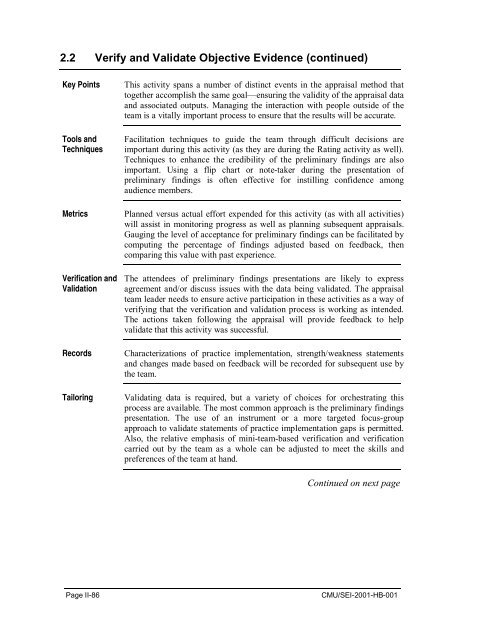Standard CMMI Appraisal Method for Process Improvement (SCAMPI)
Standard CMMI Appraisal Method for Process Improvement (SCAMPI)
Standard CMMI Appraisal Method for Process Improvement (SCAMPI)
Create successful ePaper yourself
Turn your PDF publications into a flip-book with our unique Google optimized e-Paper software.
2.2 Verify and Validate Objective Evidence (continued)<br />
Key Points<br />
Tools and<br />
Techniques<br />
Metrics<br />
Verification and<br />
Validation<br />
Records<br />
Tailoring<br />
This activity spans a number of distinct events in the appraisal method that<br />
together accomplish the same goal—ensuring the validity of the appraisal data<br />
and associated outputs. Managing the interaction with people outside of the<br />
team is a vitally important process to ensure that the results will be accurate.<br />
Facilitation techniques to guide the team through difficult decisions are<br />
important during this activity (as they are during the Rating activity as well).<br />
Techniques to enhance the credibility of the preliminary findings are also<br />
important. Using a flip chart or note-taker during the presentation of<br />
preliminary findings is often effective <strong>for</strong> instilling confidence among<br />
audience members.<br />
Planned versus actual ef<strong>for</strong>t expended <strong>for</strong> this activity (as with all activities)<br />
will assist in monitoring progress as well as planning subsequent appraisals.<br />
Gauging the level of acceptance <strong>for</strong> preliminary findings can be facilitated by<br />
computing the percentage of findings adjusted based on feedback, then<br />
comparing this value with past experience.<br />
The attendees of preliminary findings presentations are likely to express<br />
agreement and/or discuss issues with the data being validated. The appraisal<br />
team leader needs to ensure active participation in these activities as a way of<br />
verifying that the verification and validation process is working as intended.<br />
The actions taken following the appraisal will provide feedback to help<br />
validate that this activity was successful.<br />
Characterizations of practice implementation, strength/weakness statements<br />
and changes made based on feedback will be recorded <strong>for</strong> subsequent use by<br />
the team.<br />
Validating data is required, but a variety of choices <strong>for</strong> orchestrating this<br />
process are available. The most common approach is the preliminary findings<br />
presentation. The use of an instrument or a more targeted focus-group<br />
approach to validate statements of practice implementation gaps is permitted.<br />
Also, the relative emphasis of mini-team-based verification and verification<br />
carried out by the team as a whole can be adjusted to meet the skills and<br />
preferences of the team at hand.<br />
Continued on next page<br />
Page II-86<br />
CMU/SEI-2001-HB-001
















